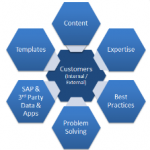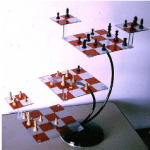Originally published on the SAP Community
The purpose of this SAP Build Apps blog is to foster ideas, share innovations, and encourage the sharing of experiences with fellow business professionals and coding experts.
Low-Code/No-Code Is an Ongoing Journey
The best way for a Citizen Developer (aka business practitioner) to gain hands on experience with SAP Build Apps is to learn how to develop an app beyond drag-and-drop.
The 5-step “dropdown with an option list” capability below is (a) guaranteed to work; and (b) helps build confidence in empowering business users.
The benefit of learning SAP Build Apps and Low-Code/No-Code overall is that business professionals, as activity and process experts, can develop applications without the technical coding skills. Given the current and projected global shortage of skilled IT and technology talent, there is an enormous opportunity for data-driven business users to respond quickly to digital-first requirements.
As a result, here’s what I have done before and after teaming with two outstanding Drexel University student interns (co-ops), Kai Thompson and Mari Cincotti who helped take my skills to the next level:
- Learn – Reviewed the SAP Low-Code/No-Code Learning Journey (Units 1 & 2)
- View – Completed the SAP Build Apps “in-apps tutorials” (located at the bottom of the UI Canvas) – Learned new terms and concepts such as logic, variables, data, and formulas.
- Proof-of-Concept – Identified and built a use case that provides value and impact.
The more of us Citizen Developers who successfully take small steps forward to develop SAP Build Apps, which are impactful, the better we can build our knowledge around Low-Code/No-Code app development throughout our ongoing learning journey!
As result, business practitioners (with occasional help) can deploy proof of concepts, pilots, and full deployment (within an IT governance framework), which provide value to our organizations, customers, partners, and employees.
Building a Dropdown With an Options List in 5 Steps
Dropdowns are very common on PC, Tablet or Mobile apps so let’s build one!
By definition, they are the way to show the user what selections they can make to help pinpoint their search results.
Step 1: UI Canvas Set-up

a) Drag the “Dropdown Field” component onto the UI canvas
b) Click anywhere on the “Dropdown Field” component to open the Properties field on the right.
c) Click under “Label Text” to rename the Dropdown.
Step 2: Set-up the list labels


d) Click on the “Option List”
d) Add labels (in this example we’ll use Food A, B, …)
Note: Make sure to use lower case for values, as it makes it easier to reduce errors later on when leveraging a backend / database.
e) Click on “Save”
Step 3: Return to the UI Canvas and click (1) “Save” and then (2) “Launch”

Step 4: Preview Your App

f) Click on “Open Preview Portal”

g) Click on “Open Web Preview” and “Open” the SAP Build App you are working on.
Step 5: Congratulations! You did it!
Where do “you” go from here?
In my case, every time I have built a part of SAP Build Apps, such as dropdowns, I feel a sense of victory!:-)
One building block of success leads to another.
Next, I suggest learning about backend / database (hosted in Visual Cloud Functions). I would have written a blog on it, but the two that were written, by Daniel Wroblewski are excellent and highly recommended:
- Unboxing: Application Backends in SAP Build Apps (Entities) (Part 1)
- Unboxing: Cloud Functions in SAP Build Apps (Part 2)
Both blogs represent an excellent step-by-step explanation.
Once you get further along, A Business User’s Guide to Becoming a Citizen Developer with SAP AppGyver (now SAP Build Apps) by Kimay Ramnarain provides an intermediate level explanation of variables, conditional logic, and REST APIs.
As business practitioners seeking this knowledge, she makes it easy and straight forward to understand concepts, which otherwise might feel daunting.
Overall, I encourage you to have a hands on understanding of how to use SAP Build Apps and focus on a use case or scenario that adds value and interests you, your team, and your organization.
Where do “we” go from here?
First, as Citizen Developers let me know if you succeed with this challenge!
Recognize that there are 2 key personas who both need to collaborate and foster ideas together:
- Software Developer/Engineers (e.g., professional coders) can provide insights on the more technical aspects of SAP Build Apps.
- Business Professionals (low- or no-coders) who have an expertise around processes, change management, and/or a specific activity requirement.
For us Citizen Developers we must realize that SAP Build Apps goes beyond drag-and-drop to make it work at an optimal level with backend data, REST APIs, automation and more.
And that’s O.K. We can do it!
Keep in mind.. Low-code does not mean low effort!
Remember that according to leading analysts from Gartner, Forrester, and IDC, the Low-Code/No-Code (LCNC) market will grow exponentially over the next few years! All the more reason for business professionals to start LCNC development and help their organizations respond quickly to digital data-driven requirements.
A few questions or comments?
- Are you a business professional leveraging SAP Build Apps? Yes or No?
– Where are you in the process? Beginner, Intermediate, Expert?
– What can you build confidently now? - What do you want to learn?
– What use cases or scenarios are you considering or working on now?
– What other how-to’s or tips are you looking for from a Citizen Developer perspective???
Let’s continue this discussion.
Greatly appreciate your comments below along with any insights, so that more Citizen Developer related content and how-to’s can be shared with a straight forward way to follow the steps and put them into action.
—
Useful Links
- Join the SAP Builders group
- Check out my prior blog – Business Teams Can Create Their Own Apps (with Occasional Help!)
- Visit the SAP Build Apps Topic Page
- Get access to the free SAP Build Apps Sandbox (30 days)
- Explore the SAP Build Apps Help Center
- Leverage SAP Appgyver Documentation – Glossary / Documentation / Quick Start
- Consider SAP Build Apps Learning, Missions, Certification












